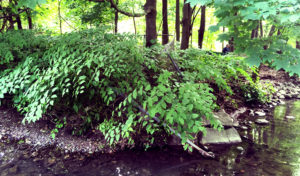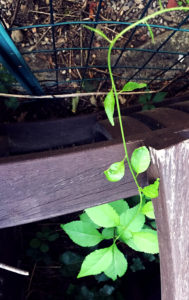
A verdant stand of Japanese knotweed crowds out all other plants along Wellington Brook behind the Belmont Library. Photo by Meg Muckenhoupt.
By Roger Colton
Belmont is under invasion. By air, land, and water, the town is experiencing the influx of non-native plants which outcompete our native species, threatening our wildlife and our waterways. The sooner that town residents begin to respond, the sooner the invasion can be thwarted.
One of the most noticeable and harmful invasive plants in Belmont is Japanese knotweed, which is growing along waterways including the Wellington Brook. Japanese knotweed threatens to displace the existing trees, shrubs, and other native plants that line the waterway. Unlike those other species, knotweed does not effectively prevent erosion or filter pollutants from runoff. As a result, large storms become an ever-greater threat to waterways as they fill with sediment and the banks are eroded away. You can see erosion by the small bridge on the Wellington Brook between the library and the Underwood estate. Knotweed also commonly grows along public right of ways. Belmont has large (and growing) stands of Japanese knotweed along Old Concord Road, and the knotweed behind the library effectively blocks any use of the Wellington Brook there.
Belmont’s invasive plants often come in attractive packages. In addition to Japanese knotweed, common invasive plants in Belmont include black swallowwort, Oriental or Asiatic bittersweet, and garlic mustard. These plants occupy both undeveloped open spaces and residential lawns and backyards. Indeed, some invasives are seen as “pretty” by homeowners who do not recognize the ecological harm they cause.
Those organizations that have an institutional role in the oversight of public lands, such as the Belmont Conservation Commission, which oversees Rock Meadow, and the Land Management Committee, which oversees Lone Tree Hill, work to control invasive plants. Unfortunately, the Department of Public Works, which oversees the town’s right-of-way corridors, has not been given the resources or the directive to control invasives. As part of routine maintenance, invasives are instead simply mowed, which causes these plants to resprout, worsening the problem. Finally, most private property owners, including Belmont homeowners, do not have the invasives even on their mental list of yard problems.
As a result, homeowners frequently do what many consider to be the worst type of control efforts. For example, pulling invasives as “weeds,” and disposing of them with yard waste simply spreads the plants to new areas. Instead, invasives removed from a private yard should be placed in a black garbage bag and disposed of in the garbage so they will be incinerated.
Eradication of invasives is likely not possible. Invasives are simply too dispersed and too ubiquitous to eliminate completely. A strategy of containment accepts current levels of invasives but seeks to prevent invasives from spreading to new sites. Another management strategy involves reducing the density or abundance of non-native species. This approach allows invasive species to persist, but at pre-defined lower thresholds. Most planners believe that invasive plant management efforts should include restoring native plants.
Eliminating substantial stands of invasives, such as the Japanese knotweed behind the Belmont Public Library on Concord Avenue, is possible, and containment of invasives in Belmont should be a near-term goal. A meaningful education program for homeowners on how to identify and dispose of common invasives would promote containment and benefit the community.
Roger Colton is co-chair of the Belmont Energy Committee. He write the biweekly “Community Conversations” column for the Belmont Citizen Herald, produces a biweekly podcast of the same name for the Belmont Media Center, and is co-host of the BMC news program Belmont Journal.



Sorry, the comment form is closed at this time.